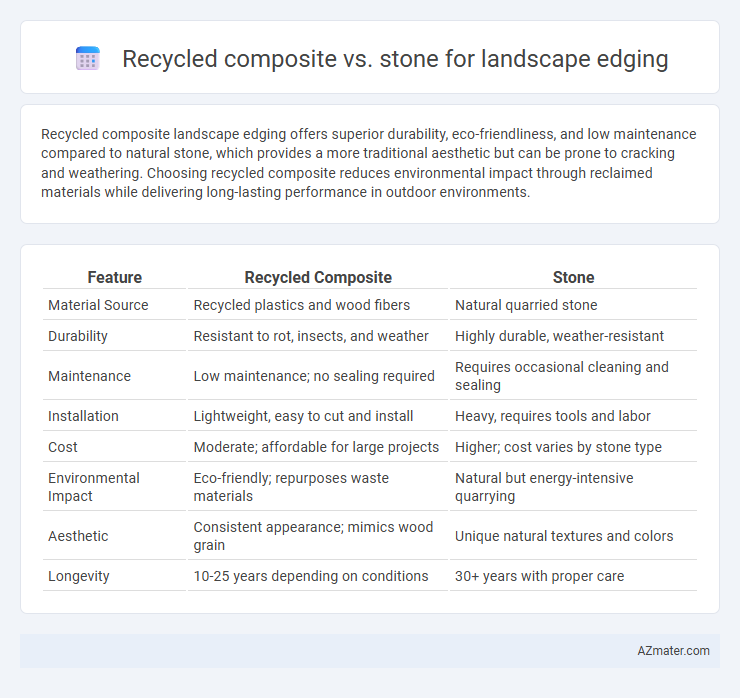Recycled composite landscape edging offers superior durability, eco-friendliness, and low maintenance compared to natural stone, which provides a more traditional aesthetic but can be prone to cracking and weathering. Choosing recycled composite reduces environmental impact through reclaimed materials while delivering long-lasting performance in outdoor environments.
Table of Comparison
| Feature | Recycled Composite | Stone |
|---|---|---|
| Material Source | Recycled plastics and wood fibers | Natural quarried stone |
| Durability | Resistant to rot, insects, and weather | Highly durable, weather-resistant |
| Maintenance | Low maintenance; no sealing required | Requires occasional cleaning and sealing |
| Installation | Lightweight, easy to cut and install | Heavy, requires tools and labor |
| Cost | Moderate; affordable for large projects | Higher; cost varies by stone type |
| Environmental Impact | Eco-friendly; repurposes waste materials | Natural but energy-intensive quarrying |
| Aesthetic | Consistent appearance; mimics wood grain | Unique natural textures and colors |
| Longevity | 10-25 years depending on conditions | 30+ years with proper care |
Introduction to Landscape Edging Materials
Recycled composite and stone are popular materials for landscape edging, each offering unique benefits in durability and aesthetics. Recycled composite edging is made from reclaimed plastic and wood fibers, providing an eco-friendly, low-maintenance option resistant to rot, pests, and weathering. Stone edging, sourced from natural granite, limestone, or slate, delivers a timeless, sturdy border that enhances garden design with its natural texture and color variations, requiring minimal upkeep.
Overview of Recycled Composite Edging
Recycled composite edging for landscape projects is crafted from reclaimed wood fibers combined with recycled plastics, offering a sustainable alternative to traditional stone. This material resists rot, insects, and weathering, ensuring durability and low maintenance. Its flexibility allows easy installation along curved or uneven garden borders, making it an ideal choice for eco-friendly landscaping.
Understanding Natural Stone Edging
Natural stone edging offers a timeless, durable solution for landscaping, providing a variety of textures and colors that blend seamlessly with outdoor environments. This material resists weathering and erosion, making it ideal for long-term garden borders and pathways. Compared to recycled composites, natural stone provides superior weight and stability without the risk of fading or warping over time.
Durability and Longevity Comparison
Recycled composite landscape edging offers superior durability compared to stone, as it resists cracking, splitting, and fading caused by weather exposure. Stone edging, while aesthetically natural and heavy-duty, can be prone to chipping, erosion, and shifting over time due to freeze-thaw cycles and soil movement. The longevity of recycled composite materials often exceeds 25 years with minimal maintenance, whereas stone may require periodic repair or replacement to maintain its structural integrity.
Aesthetic Appeal and Design Versatility
Recycled composite landscape edging offers a modern aesthetic with wood-like textures and consistent color options that resist fading and staining, enhancing garden design versatility. Stone edging provides a natural, timeless appearance with unique textures and color variations, perfect for rustic or classic garden styles. Both materials accommodate diverse landscape designs, but recycled composite allows more customization and uniformity for contemporary settings.
Installation Process and Ease of Use
Recycled composite landscape edging offers a straightforward installation process with lightweight materials that are easy to cut and shape, requiring minimal tools and effort compared to stone. Stone edging often involves heavier, more time-consuming placement and may require additional equipment for leveling and secure positioning. The ease of use of recycled composite products enhances efficiency and reduces labor costs, making it a preferred choice for quick, clean installations.
Environmental Impact and Sustainability
Recycled composite landscape edging reduces landfill waste by utilizing reclaimed plastics and wood fibers, significantly lowering carbon emissions compared to stone quarrying, which involves extensive energy use and habitat disruption. Composite materials offer long-term durability and resistance to rot without chemical treatments, enhancing sustainability through reduced maintenance and replacement frequency. Stone edging, while natural and biodegradable, often requires heavy machinery for extraction and transportation, contributing to higher environmental degradation and fossil fuel consumption.
Cost Analysis: Recycled Composite vs Stone
Recycled composite landscape edging typically costs between $3 to $5 per linear foot, offering a budget-friendly alternative to natural stone, which ranges from $10 to $25 per linear foot depending on the type and quality. Installation expenses for recycled composite materials are generally lower due to lighter weight and easier handling, while stone requires skilled labor and additional groundwork, increasing total costs. Long-term maintenance costs favor recycled composite as it resists weathering and decay, unlike stone, which may need periodic resetting or replacement due to cracking or shifting.
Maintenance Requirements and Lifespan
Recycled composite landscape edging requires minimal maintenance due to its resistance to rot, insects, and weathering, typically lasting 20 to 30 years without refinishing. Stone edging is highly durable with a potential lifespan exceeding 50 years but may require periodic cleaning and repositioning due to shifting or settling. Choosing recycled composite reduces upkeep time and effort, while stone offers longevity with occasional maintenance to preserve its appearance.
Choosing the Best Material for Your Landscape Edging
Recycled composite landscape edging offers durability, resistance to rot, and eco-friendly benefits by utilizing reclaimed materials, making it ideal for sustainable garden designs. Stone edging provides a natural aesthetic, longevity, and minimal maintenance, blending seamlessly with various landscape styles while withstanding harsh weather conditions. Choosing the best material depends on factors such as budget, desired appearance, maintenance preferences, and environmental impact, ensuring your landscape edging meets both functional and design goals.

Infographic: Recycled composite vs Stone for Landscape edging
 azmater.com
azmater.com